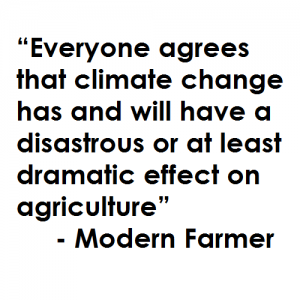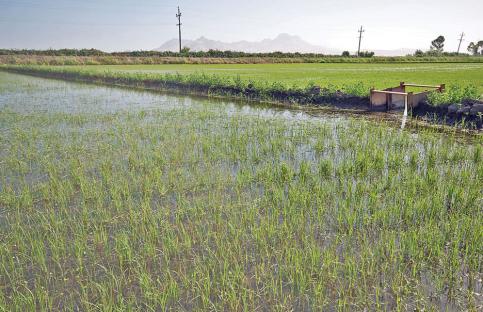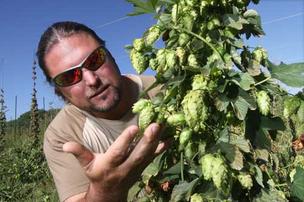 You may have heard by now about “climate-smart agriculture.” It’s the catchphrase that came out of the United Nations Climate Summit this week and the reason I was in New York to participate in a panel discussion on how to achieve food security for a growing population in a climate-changing world.
You may have heard by now about “climate-smart agriculture.” It’s the catchphrase that came out of the United Nations Climate Summit this week and the reason I was in New York to participate in a panel discussion on how to achieve food security for a growing population in a climate-changing world.
More than 20 governments and 30 organizations announced they would join the newly launched Global Alliance for Climate-Smart Agriculture, which aims to enable 500 million farmers worldwide to practice climate-smart agriculture. This is wonderful. But what does it mean in practice?
My colleagues and I have been asking ourselves this question since the concept was originally introduced by the UN’s Food and Agriculture Organization in 2010. Over the past four years, we’ve done some hard thinking on which practices, precisely, will get us to a point where we can keep pace with the food demands of a growing global population and increase the resiliency of our food systems to the harsh impacts of climate change.
Defining the catchphrase
As Modern Farmer put it, “everyone agrees that climate change has and will have a disastrous or at least dramatic effect on agriculture,” but everyone does not necessarily agree on the appropriate course of action.
We have made some real progress to define and subscribe to a set of next steps that can start to achieve climate-smart agriculture.
To start, we need to get to the root cause. We need to encourage farmers to abandon or significantly reduce their reliance on practices that increase greenhouse gas emissions. After all, what is the point of adapting to climate change if we aren’t also making an effort to slow it down? By reducing greenhouse gas emissions today, we are reducing the possibility and frequency of future needs for adaptation.
We are already seeing examples of this taking place in California, where the California Air Resources Board has published draft standard for the development of carbon offsets for farmers who want to earn credits through greenhouse gas reductions. By reducing the amount of methane generated through rice cultivation, a California rice farmer can generate a carbon credit that can be sold to companies to offset their carbon emissions, generating a new revenue stream for the farmer and reducing overall emissions.
Next, we need to reconsider business-as-usual. Current farming strategies are not going to cut it in a world with more mouths to feed and more unpredictable climate conditions. With more frequent and severe weather events, transforming landscapes and increasingly unreliable supplies of water and other inputs, we need strategies that are more flexible, efficient and adaptable than ever before.
In New Mexico, Mike De Smet – an organic, raw dairy farmer – has responded to drought by improving efficiencies. He has laser-leveled all of his fields and transitioned to no- and minimum-till planting to support the productivity of his herd and save water. By enhancing his irrigation efficiency and stewardship, Mike expects to grow his herd to full capacity – around 100 head – in the next five years while simultaneously saving water.
Finally, we need to get high-tech. In order to cut greenhouse gas emissions and improve efficiencies, we need significant investments in new and developing technologies that can help farmers achieve this.
In Ohio, where fertilizer runoff in Lake Erie threatens clean drinking water, recreation and public health, new tools and technologies are being developed to help farmers optimize fertilizer applications in ways that minimize nutrient loss to air and water while increasing or maintaining yields. Together, we have developed platforms – such as the Adapt Network – for testing rates, timing and placement of nitrogen and phosphorus to improve efficiencies and reduce pollution.
With these three next steps in mind, I am confident that we can make significant progress towards achieving climate-smart agriculture.
We also have to remember that, while the term may be relatively new, there are countless farmers out there already practicing climate-smart agriculture. Sustainability is and always has been at the core of what farmers, ranchers and other producers do as daily stewards of our working lands. Many of them have already proven that these climate-smart practices not only help reduce emissions and increase efficiencies, but also increase yields and, ultimately, revenue.
Now that we have a clear commitment from the United Nations, I look forward to a day, hopefully in the not-too-distant future, where we have achieved climate-smart agriculture on a global scale.












One Comment
Dr. Shaw is obviously concerned about the food system when she states that “we’ve done some hard thinking on which practices, precisely, will get us to a point where we can keep pace with the food demands of a growing global population and increase the resiliency of our food systems to the harsh impacts of climate change.” I agree that the food system needs reform but my objection to her assessment arises out of her use of the plural personal pronoun “us” and “we.” We should radically reduce our consumption of meat and we should increase our consumption of fish and we need significant investments in new and developing technologies etc. lack an antecedent for exactly whom “we” refers to. “We” comprises consumers and farmers, Republican and Democratic legislators, feed, equipment and fertilizer manufacturers, nutritionists, academics, students, people of all socio-economic classes and of all nations and all ethnicities. Even assuming for the moment they all had equal access to the information in your writing and all knew what the state of agriculture is, they would not all share your analysis that something is wrong with it or your prescription for making it right. I do not suggest you do not know this, only that your readers, who are all by default conscientious food consumers or they would not have taken up your writing, may, and probably certainly do not, know this.
I am a retired organic dairy farmer. Dairy farmers must learn to navigate advice coming from a broad range of people, chief among them federal and state governments, university extension agents and trade magazines none of whom hold feeding people topmost among their goals. Farmers do not either; their first and perhaps only priority is to survive.
Vermont is the only “farming” state in New England and we are a virtual island: we have water on three sides and a vast agricultural desert stretching from our southern border all the way down to New Jersey or Pennsylvania. But we do not “feed the world” and we have no capacity nor any responsibility for doing so. We do not even feed ourselves. Again, I do not mean to imply that you do not know this. But you do not circumscribe or frame the issues you write about in geopolitical terms and then you prescribe a single solution for the entire world on the grounds that we will soon have 9B people on the planet and “we” have to feed them. This is a conceit. There are three spheres of agriculture: the world, whose nutritional problems are unimaginably vast and most probably intractable, the nation, whose nutritional problems are merely maddeningly intertwined with our politics and therefore contentious and Vermont, whose agricultural problems are complex but not unmanageable. Vermont, with a population of only 600,000 people, considers itself a farming state. We too comprise farmers, legislators, feed, equipment and fertilizer dealers, nutritionists, academics, students and people of all socio-economic classes and yet we do not have consensus on the food and water crisis or what should be done about it. That is largely because (i) Vermonters are still in thrall to the Jeffersonian agrarian ideal, which prevents our thinking realistically about what farming once was, what it became after WWII and what is is today; (ii) few understand that our regional farming and water quality issues are not decided on the farm or in Montpelier but in Washington and (iii) Vermont’s farmers, overwhelmingly conventional dairy farmers who number only 600, or 1/10th of 1% of the population, make 2.6B lbs of commodity milk, which seems like a lot until you realize it is barely 1% of the national supply and not even a quarter of the perennial 12B lb national surplus. Inconvenient truth: if all Vermont’s dairy farmers up and went out of business tomorrow, no one would notice. Grocery stores would still be stocked day and night with milk made at a loss by farmers in other states. This runs counter to the official line, which is that our farmers must have a safe haven from regulations because “they make ‘our’ food and keep ‘our’ land open.” Operating from this fallacy, our legislators have enacted a set of policies which assert that even though we do not provide them with a market, Vermont must subsidize farmers to keep them in business. The most conspicuous results of the $60/80M/year the legislature appropriates for farmers and the $10M it spends to clean up after them is the resilience of farm attrition and lake pollution, the two problems the appropriation is always intended to address.
So if one takes, as I do, the frame “Vermont agriculture,” then “we” — still a very large, inclusive concept but much much smaller than yours — only need to address the problems “we” face here. I see the problem this way: conventional farming was invented after WWII to raise yields and lower costs, which it accomplishes by replacing traditional methods of mechanical weed control, soil fertility and labor with cheap toxic chemicals, the residues of which it discharges into the environment. The paradigm works but because it over produces its markets, it drives farm prices down, which drives farm attrition, consolidation and expansion. That in turn drives greater reliance upon artificial fertilizers and herbicides on more land in the annual flood plain and therefore more lake pollution. The paradigm was designed to favor urban consumers and food manufacturers. Farmers like it because they want naturally enough to raise their own yields and lower their own costs. But the paradigm was designed without regard to exogenous systems like water quality and the health of the rural economy and that is where “we” enters the picture. “We” should have no problem if farmers wanted to invest $2/3M in their operations and work all day and all night to subsidize urbanites with cheap milk. But the conventional paradigm is responsible for polluting the commons and “we” cannot permit that. That in turn gives society the right to prevent farming methods that trespass on the rights of others, which raises fifth Amendment takings issues and private property issues, which farmers and consumers do not generally understand.
Organic farming was exquisitely invented as an antidote to these problems and since it does not allow these toxins and nor, as above, do we depend upon Vermont agriculture for our food, we should demand that if we are going to farm, and I strenuously agree that we should, we must convert all our farms to organic. But the highest most persistent obstacle to the success of organic is the universal availability in the marketplace of its cheap, environmentally destructive alternative, conventional milk. “We” cannot achieve island status for Vermont organic to say nothing of our water quality standards unless and until “we” extirpate conventional dairy.